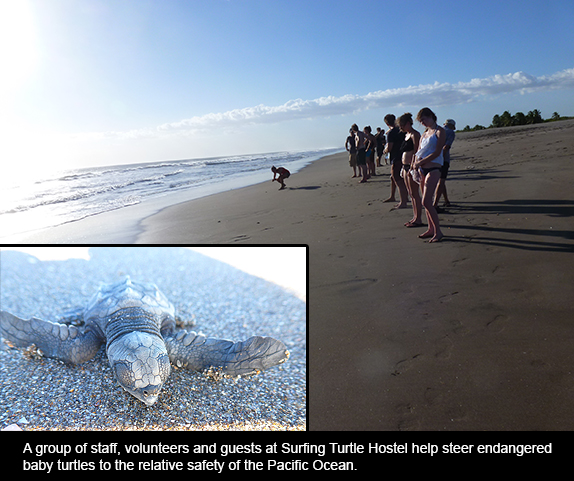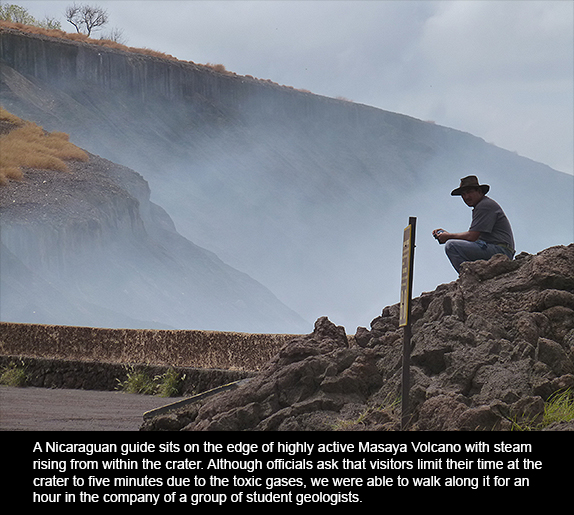
This is the third in a series of columns on a journey through Nicaragua. Photos by Thelma Bowles.
During our trip to Nicaragua, we spent a night on Las Brasiles, a narrow 5-mile-long barrier island off the northern Pacific coast. The island is entirely owned by its only inhabitant, an eco-hostel called Surfing Turtle whose mission is to help endangered turtles survive.
Employees aided by volunteers and guests rescue, feed and protect baby turtles and then set them free en masse on the beach for their march to the ocean. It is a trip for people and turtles alike. We had to help steer the tiny babies toward the ocean when they periodically lost their direction and wandered in circles. We cheered in triumph when the last baby finally took the plunge into the high tide and floated away.
Ecology is a big deal in Nicaragua. Sometimes it seems like 90 percent of the hostels call themselves eco something or other. Many of the foreigners in the country work on one of the innumerable environmental projects. One-fifth of the country is protected in national parks or conservation areas, although none of them has developed infrastructure for tourists. Even marked trails are a rarity.
Certainly, if any country in the world needs environmental awareness, it is Nicaragua. Much of the land has been stripped bare of its original forests, and the deforestation continues. Some of it is due to logging contracts with foreign companies, but much of it is attributable to Nicaraguans themselves: Campesinos desperately seeking fields clear forests to make way for coffee, tobacco and sugar cane.
Most of its lakes, including Nicaragua, Managua and Masaya, are polluted, primarily by agricultural runoff and perhaps by human waste, although reports of the latter were in conflict. The country has been in a drought for the past two years, and the result is evident everywhere. Some towns have run out of water. Land stripped of vegetation is giving rise to dust storms that swept over Léon and other cities while we were there. Normally the climate alternates between a June through November wet season and seven months with little rain. But of late the rains have been failing, a tragedy that many in Nicaragua blame on global climate change.
Climate change has also affected Nicaragua in another way. Perversely, in the midst of drought, the Caribbean Sea is rising and has submerged several small islands off the east coast of Nicaragua.

The government has no money to deal with environmental problems. It is, however, doing all it can to expand use of alternative energy. Already nearly half the electricity derives from renewable sources—solar, wind, hydroelectric and volcanic geothermal power, and the goal is to increase that total to 80 percent (the comparable U.S. figure is 13 percent). Such a program is a matter of survival for Nicaragua, which until now has depended on dirt cheap oil from Venezuela that everyone expects to dry up soon since Venezuela itself is near bankruptcy.
In a country with few natural resources and no industry, there are limited hopes for the economy. Most Nicaraguan children are said to drop out of school after the third grade because there are no jobs to reward further schooling. We had a chance to talk with a group of middle class students from a private high school in Managua, and many of them say they will have to go abroad for further education and jobs.
The one great hope for economic growth is dismissed by many as only a chimera. The government has concluded a secretive agreement with a Chinese businessman to build a $50 billion complex, the most expensive project in world history. The focus of the complex is a canal between the Atlantic and the Pacific to rival the Panama Canal, but it also includes two new seaports, resort hotels, industries and other facilities.
The project raises huge problems and a host of unanswered questions. One is the financing. No individual has that kind of money to throw at a single, very speculative project. The Chinese government says it has nothing to do with it, but without that government, no one can imagine how the canal would ever get built. Complicating the financial calculations, there does not seem to be enough business to support two canals, meaning that the only rationale for the canal would be political rather than commercial.
The canal route includes not only crossing Lago Nicaragua, but also dredging and deepening its 20-foot average depth so that the largest tankers and container ships can use it. Such a project would split the lake and the country as a whole, threaten to pollute Lago Nicaragua, destroy some of its unique life, including the world’s only fresh water sharks, and jeopardize Isla Ometepe, a foremost tourist attraction.
The project will also require taking land from Indians near the Caribbean Sea and small farmers along the lakeshore—land that was at the heart of the revolution against Somoza and that was only given to the campesinos a few decades ago.
All the evidence is that a majority of Nicaraguans support the canal project. This support is due in part to desperation over where Nicaragua can find sources of growth. It is also attributable to the continuing popularity of the Sandinista government led by President Daniel Ortega.
In manipulated, unconstitutional and non-transparent balloting, he won reelection decisively. He also controls an overwhelming legislative majority. In fact he and his allies control virtually every font of power in the country, including television and big business. Posters all over the country hail him simply as “Daniel.”
Some of the posters show him accompanied by his wife, Rosario Murillo, who seems to be the one actually running the government. While her husband has retired into near invisibility, she makes all government announcements, hires and fires members of the cabinet, promotes social programs protecting women, children and the environment, and seems to be emerging as Ortega’s successor. However, she lacks his charisma and popularity and is sometimes referred to as “la bruja,” the witch.
What kind of future Nicaragua will have is, as Churchill said of the Soviet Union, a riddle wrapped in a mystery inside an enigma. One knowledgeable expat said the country could aspire to the level of Guatemala or Honduras, but “it is inconceivable it could equal Costa Rica or Panama in my lifetime.”
But Nicaragua does not want to be the next Costa Rica, an adjacent country which has justifiably earned a reputation as grotesquely expensive (a restaurant owner told me he found it more expensive to operate a business in San Juan, Costa Rica, than in New York City) and as a kind of reserve for wealthy American retirees.
Nicaragua is still itself, very different from any other Latin American country, with a host of unique weaknesses and equally unique strengths. It preserves its natural resources in parks but sells its logs to anyone who wants to buy. Its women drive trucks and motorcycles but are forbidden to have abortions even to save their own lives. Its journalists are not imprisoned, assaulted or killed, but they are denied access to virtually all information about the government. Nicaragua clearly wants to remain itself, a different kind of country; this is a notable challenge in a world of globalization and increasing homogeneity. The most important question, however, is which of the contradictory facets of its character will ultimately triumph.



Responses to “Nicaragua, Part 3: Blessed and cursed by geography”